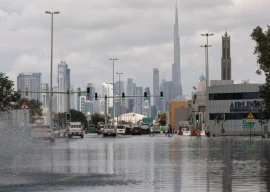
As textile exports turned negative in the first quarter of the ongoing fiscal year due to persistent energy crisis, the government on Tuesday made a ‘soft promise’ to provide gas to the industry in winters. It is aiming to keep factories operating at least on one-third of their production capacity.
The government reacted only when the textile industry made a hue and cry about the $1 billion losses it sustained in the past six months and a potential $2 billion further loss in the coming months if the industry completely shut down due to the energy shortage.

The promise to provide 100 million cubic feet per day (mmcfd) of gas to the textile industry was made by Finance Minister Ishaq Dar during a meeting with industry representatives, said SM Tanveer, chairman of All Pakistan Textile Mills Association. He was briefing the media along with Textile Minister Abbas Afridi after holding a meeting with the finance minister.
“It is the Ministry of Petroleum and Natural Resources’ concern where it diverts the gas from to keep the factories running during winters,” said Afridi.
He said that despite acute gas shortage, the government would make sure that the factories are run at least six hours a day during winters.
According to the figures released by Pakistan Bureau of Statistics on Tuesday, the textile group exports plunged 4% to $3.4 billion during July-September period of the current fiscal year. The reduction was across the products with a maximum decline of 63% in cotton carded. The exports of raw cotton contracted 24%, cotton yarn 21.8% and cotton cloth 13.5%.
The exports have fallen despite the country availing duty free access to the European markets. The Generalised System of Preference (GSP) plus became effective from January this year. “We have not yet started yielding results of the GSP Plus due to deepening energy crisis,” said Tanveer.
He said after the implementation of the GSP Plus status, the textile industry had planned to double its exports to $26 billion in five years from the current $13.7 billion.
Since April, the textile industry sustained $1 billion losses due to reduction in exports. “Our fear is that if the industry is completely shut down in winter there will be an additional loss of $2 billion,” said Pakistan Textile Exporters Association Chairman Sohail Pasha.
He said losses due to gas closure were only limited to Punjab as textile mills located in Sindh were getting gas 24-hours a day. According to industry’s estimates, Punjab holds 70% share of the total textile exports of the country.
The government has so far neglected the exports as an area to enhance foreign inflows; it is focusing more on getting foreign loans, according to independent economists. They added that the aid-driven growth model adopted by the PML-N government would not resolve the country’s external financial woes.
Cost Differential impact
“The discrimination in supply of gas between Punjab and Sindh has put the industries in Punjab at a disadvantageous position,” said SM Tanveer. He added that due to inputs’ price differential, the textile industry of Punjab sustained Rs82 billion annual losses. Overall, industries in Punjab have sustained Rs150 billion losses in one year, he said.
He also said that Dar assured that the government would soon issue notifications to put into effect the incentives it offered in the last budget. The industry also demanded that the government should also timely pay tax refunds and their money should not be used to artificially balloon the revenue collection.
Published in The Express Tribune, October 22nd, 2014.
Like Business on Facebook, follow @TribuneBiz on Twitter to stay informed and join in the conversation.
COMMENTS (1)
Comments are moderated and generally will be posted if they are on-topic and not abusive.
For more information, please see our Comments FAQ













































Energy outage is one of the main hurdle to exploit the advantage of GSP plus in European markets . Use of alternate energy increases the production cost as well as require additional capital expenditure. Export of textile and apparels from the neighboring India , a competitor for the year 2013-14 is 39 billion US Dollar ( they rather exceeded their export target) Cheaper energy is a must to remain competitive in the existing as well as the new markets.